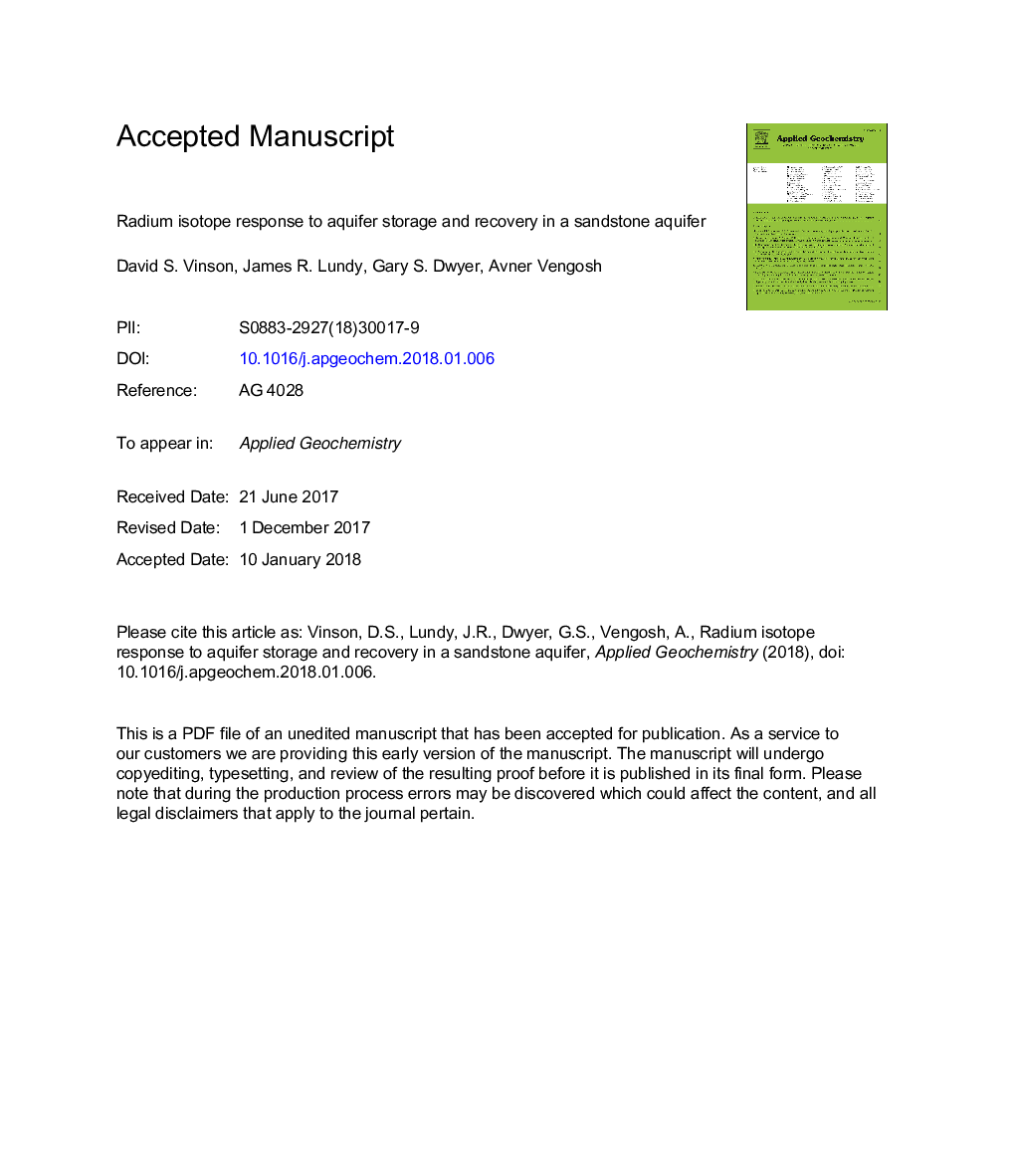| کد مقاله | کد نشریه | سال انتشار | مقاله انگلیسی | نسخه تمام متن |
|---|---|---|---|---|
| 8863149 | 1620200 | 2018 | 36 صفحه PDF | دانلود رایگان |
عنوان انگلیسی مقاله ISI
Radium isotope response to aquifer storage and recovery in a sandstone aquifer
ترجمه فارسی عنوان
پاسخ ایزوتوپ رادیوم به ذخیره سازی آبخوری و بازیابی در آبخوان ماسه سنگی
دانلود مقاله + سفارش ترجمه
دانلود مقاله ISI انگلیسی
رایگان برای ایرانیان
کلمات کلیدی
رادیوم، استرونتیوم، ایزوتوپها، ذخیره و بازیافت آب سنگین، ماسه سنگ،
موضوعات مرتبط
مهندسی و علوم پایه
علوم زمین و سیارات
ژئوشیمی و پترولوژی
چکیده انگلیسی
Radium isotopes and water-rock interaction were evaluated in an aquifer storage and recovery (ASR) pilot study conducted in 2010-2011 in Minnesota (USA) in order to identify mechanisms governing Ra activities when low-Ra water is recharged into a sandstone aquifer. Groundwater in the aquifer selected for the study, the Cambrian Mt. Simon Sandstone, contains naturally occurring radium that in many areas exceeds United States drinking water standards (185 mBq/L or 5â¯pCi/L combined 226Ra+228Ra), highlighting the need to identify the rates and mechanisms by which stored water acquires Ra isotopes. Major element concentrations of recovered water largely resembled recharged water, while Ra activities exceeded the Ra activities of the recharged water. 224Ra reached â¼100 mBq/L during the first 8â¯h of recovery (overall range 15.5-133 mBq/L). 226Ra and 228Ra also increased during the 47-day recovery period (23.7-82.5 mBq/L and 33.7-85.5 mBq/L, respectively). Ra isotope ratios indicate the relative contribution of alpha recoil vs. chemical processes (e.g. adsorption/desorption). During recovery, the 224Ra/228Ra and 228Ra/226Ra ratios declined, approaching their expected limiting values near unity. Collectively, the rates of Ra activity change with time, trends in Ra isotope ratios, barium concentrations, and manganese concentrations suggest that Ra was governed by chemical processes and alpha recoil, in which the half-lives of each Ra isotope determined the primary mechanism(s) controlling radionuclide mobilization from the aquifer solids. Radium-mobilizing processes during storage may include: (1) recharge of low-Ra water into an aquifer containing high-Ra groundwater induced adsorption/desorption disequilibrium and caused net Ra desorption; (2) chemical conditions during storage (e.g. the Ba content of the recharge water or the reducing conditions in the aquifer) could have further released Ra from the aquifer solids or reduced the effectiveness of Ra adsorption; and/or (3) mobilization from radioactive decay of solid-phase thorium parents (alpha recoil) contributed Ra isotopes into the low-Ra recharge water. The short-lived 224Ra was released dominantly by alpha recoil while the longer-lived 226Ra was dominantly released by chemical mechanisms such as desorption. Radium-228, of intermediate half-life, also appears to have been released predominantly by alpha recoil, although significant chemical release of 228Ra cannot be ruled out. Accordingly, at near-neutral pH, groundwater geochemical conditions (such as redox state and/or shifts in Ra activities or Ba concentrations) can influence observed Ra activities in recovered water, which in proportional terms impart the largest effect on the longer-lived 226Ra. Given the roles for both alpha recoil and chemical reactions, the duration of storage could influence radium activities in recovered water from ASR wells.
ناشر
Database: Elsevier - ScienceDirect (ساینس دایرکت)
Journal: Applied Geochemistry - Volume 91, April 2018, Pages 54-63
Journal: Applied Geochemistry - Volume 91, April 2018, Pages 54-63
نویسندگان
David S. Vinson, James R. Lundy, Gary S. Dwyer, Avner Vengosh,
